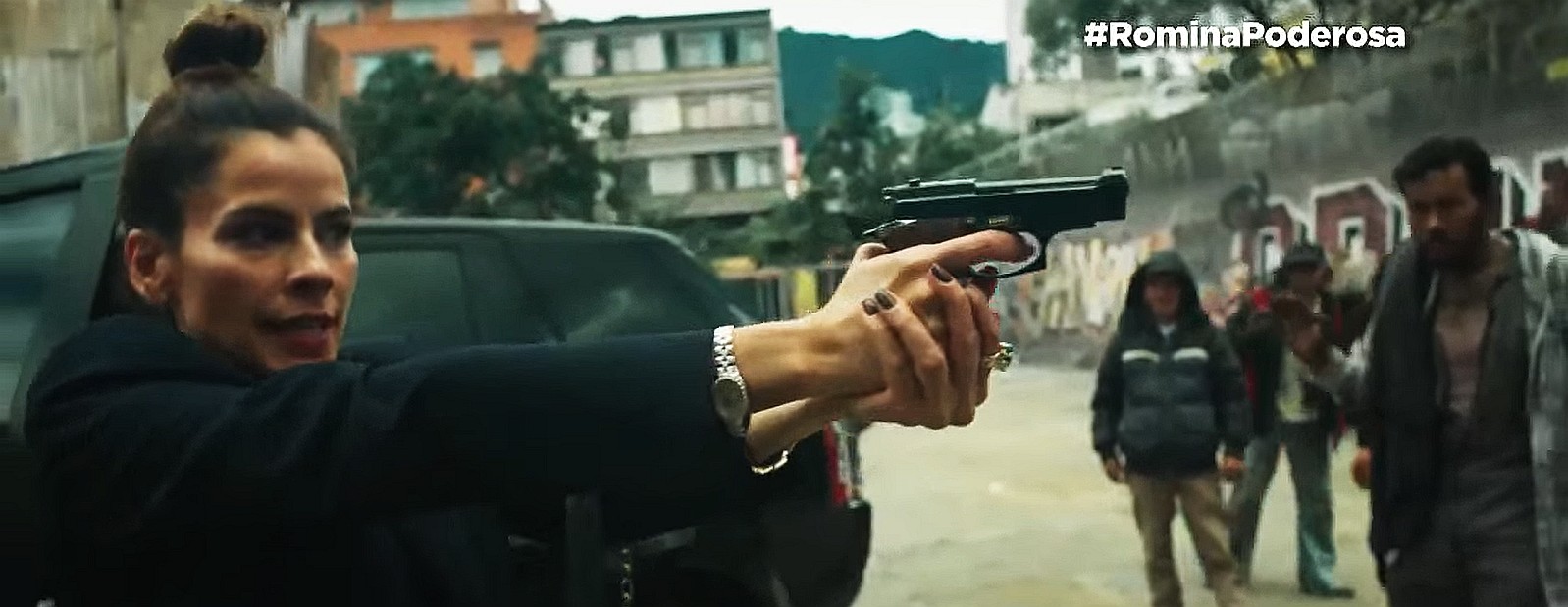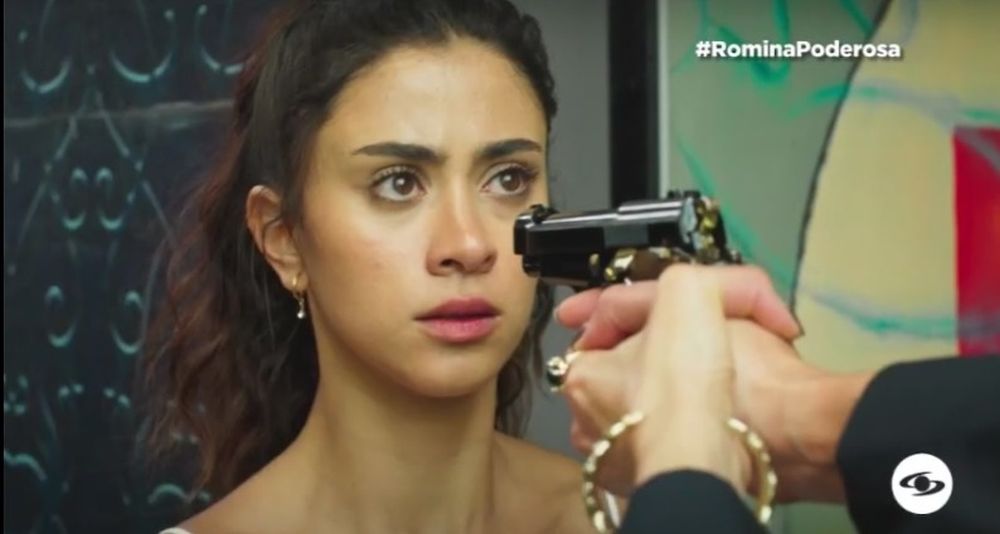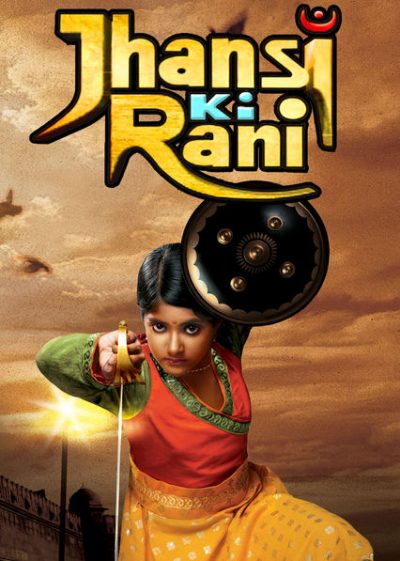 ★★★
★★★
“Life going in cycles.”
The concept of twins, separated at birth, is one which has been used frequently in films and television. Sometimes for comedic effect, such as Arnold Schwarzenegger and Danny DeVito in Twins, or the two Jackie Chans in Twin Dragons. But also for dramatic impact: the most famous example is probably that of Luke and Leia in the Star Wars franchise, who were parted in order to hide them from their father. In our genre, Orphan Black works along similar lines. But this Colombian telenovela goes full-bore into it, across almost the entire duration of its sixty-seven episodes, with the concept a young woman adopting her twin’s identity being at the core of the show.
It begins with Romina Paez (Molina), who is a BMX champion in the Mirla, a poor neighbourhood. After winning a race, she uses the interview to rail against the loan sharks who prey on the locals, offering much-needed money at extortionate rates, and extracting repayment with brutal violence. This interview has two results. Firstly, the Chitiva brothers who run the loan sharkage, are unimpressed, and decide Romina should pay. Secondly, it brings Romina to the attention of rich girl Laura Vélez (also Molina), who sees Romina is her spitting image. She goes to investigate, and finds that they actually have a common mother. Mom used to work for Laura’s dad, got pregnant and had them both. Dad took Laura to his family as “an adoptee”, while Romina remained with her natural mother.
 These two elements clash, when the Chitiva brothers order the assassination of Romina and her mother. Except, it’s actually Laura is killed, while visiting her mother in the barrio. Romina escapes, and decides the best option is to pretend to be dead, and indeed, pretend to be Laura. However, Romina/Laura is intent on bringing those responsible for “her” death to justice, and it’s not long before reports of Romina’s ghost haunting her old stomping grounds are passing around. Investigating from the position of law is honest cop Cristobal “Whiz” Ruíz, who eventually comes to know Romina’s secret. But in another twist, the crime lord at the top of the tree, above the Chitivas… is Laura’s mother, Virgina Vélez (León).
These two elements clash, when the Chitiva brothers order the assassination of Romina and her mother. Except, it’s actually Laura is killed, while visiting her mother in the barrio. Romina escapes, and decides the best option is to pretend to be dead, and indeed, pretend to be Laura. However, Romina/Laura is intent on bringing those responsible for “her” death to justice, and it’s not long before reports of Romina’s ghost haunting her old stomping grounds are passing around. Investigating from the position of law is honest cop Cristobal “Whiz” Ruíz, who eventually comes to know Romina’s secret. But in another twist, the crime lord at the top of the tree, above the Chitivas… is Laura’s mother, Virgina Vélez (León).
Yeah, it’s a fairly ridiculous concept, and what unfolds over the rest of the show often teeters on the brink of implausibility. While I get the “twins” thing, the idea that after twenty entirely separate years of upbringing, in utterly different circumstances, they would still perfectly resemble each other physically, to the extent that even their own parents can’t tell them apart, strains credulity. Romina basically blames everything from the sudden loss of memory to her changes in personality on a head injury, and after a quick visit to the doctor, who naturally pronounces her right as rain, that’s the end of the matter. She still has to manage her double life, and the ever-expanding circle of people who know about it, on both sides of the class divide.
Inevitably, there’s a whole lot of soap-opera nonsense going on here, across the uniformly photogenic cast. Laura’s boyfriend falls for Romina, Whiz falls for Romina, Whiz’s colleague falls for him, and it all gets incredibly messy emotionally. This is probably the least interesting part of the show, though it does occasionally work. The final episode, for example, has Whiz pouring out heart in wedding karaoke, but it’s done with such obvious and heartfelt sincerity, that it powers past the obvious schmaltzy aspects, and I was genuinely happy for the man. On the other side, Leo Chitiva (Bury) is the most interesting of the low-level villains. He’s another one who loved Romina, but his criminal life is incompatible with that, leaving him with difficult, yet interesting, choices.
I say “low-level,” because I think my favourite character is likely Virginia, especially as the show proceeds and she needs to become increasingly ruthless (as shown, top) as she struggles to escape the net closing around her. I would love to have seen a prequal series, explaining in more details exactly how she went from humble origins, both to running a major criminal organization, and also marrying her, apparently utterly oblivious husband. I get that some spouses are oblivious to their other halves being a serial killer, and also there’s Virginia’s “charitable foundation” which probably operates as a front. Still, I suspect I’d have at least something of a clue, if Chris was running the Cuban mafia out of the office here.
There is a bit of weirdness here: the Colombian version of the show runs for 67 episodes, but there are only 65 on Netflix. It’s possible there may also be differences in the ordering, but I haven’t been able to confirm that. I’m not sure why two episodes would not be available on Netflix. While other streaming services have removed episodes for content (such as the blackface episodes on It’s Always Sunny in Philadelphia, I can’t think of anything here which would be so contentious. My instinct might be music rights: the show uses a lot of popular Colombian songs and artists, and getting clearance globally could have proved too problematic. I can’t say I noticed at the time, though it isn’t really the kind of show that demands 100% of your attention.
I would like to have seen Romina make more use of her BMX skills. This is significantly stressed earlier, but definitely fades out of the picture as we get deeper into things. But between Virginia and some of the other women characters, such as Whiz’s partner Alex Bedoya (Camila Rojas), who is occasionally a bit of a bad-ass, it does end up qualifying for the site. It ends more or less as you would expect, but if my somewhat shaky Spanish is to be believed, there is a second series on the way. Though with the Spanish language title perhaps being Romina Embarazada, which translates as “Pregnant Romina,” I’m not certain I’ll be writing about it here!
Dir: Rafael Martínez Moreno
Star: Juanita Molina, David Palacio, Zharick León, Kevin Bury
a.k.a. Romina Poderosa






 ★★★
★★★ There are quite a lot of familiar faces for this one. There’s the long-running relationship between Teresa and Russian mobster, Oleg Yosikov (Gil). This is somewhat reflected in the love triangle of her daughter, now very much her own young woman. Sofia has to decide between Oleg’s son, Fedor, and street-kid Mateo Mena. He rescues Sofia from a sticky situation, and those who want to use Sofia to force her mother into compliance with their wishes. There’s also faithful sidekick Batman, who has been with Teresa since the beginning. On the other side, as well as her ex-husband, whose power is now grown to such an extents as to be a real threat, there’s long-running DEA nemesis Ernie Palermo. He brought Teresa in, and is very keen for her to serve the rest of her eighty-five year prison sentence.
There are quite a lot of familiar faces for this one. There’s the long-running relationship between Teresa and Russian mobster, Oleg Yosikov (Gil). This is somewhat reflected in the love triangle of her daughter, now very much her own young woman. Sofia has to decide between Oleg’s son, Fedor, and street-kid Mateo Mena. He rescues Sofia from a sticky situation, and those who want to use Sofia to force her mother into compliance with their wishes. There’s also faithful sidekick Batman, who has been with Teresa since the beginning. On the other side, as well as her ex-husband, whose power is now grown to such an extents as to be a real threat, there’s long-running DEA nemesis Ernie Palermo. He brought Teresa in, and is very keen for her to serve the rest of her eighty-five year prison sentence.
 Halfway through the final installment, Chris came in. She paused, watching for a moment, then said, “They spend far too much time talking, and not enough time killing.” Just a shame she waited 93 episodes to express so succinctly one of the main problems with the series. For, even if the final arc had its share of bloodshed, if you average it out per show, it’s about the level of a mid-strength nosebleed. It certainly put the novela into narconovela. Though the problems began at the start – or, rather, the end of the second series where heroine Sara Aguilar was apparently gunned down. This being a show where escape from death was common, I spent the first 20 episodes waiting for her to return. Spoiler: she doesn’t.
Halfway through the final installment, Chris came in. She paused, watching for a moment, then said, “They spend far too much time talking, and not enough time killing.” Just a shame she waited 93 episodes to express so succinctly one of the main problems with the series. For, even if the final arc had its share of bloodshed, if you average it out per show, it’s about the level of a mid-strength nosebleed. It certainly put the novela into narconovela. Though the problems began at the start – or, rather, the end of the second series where heroine Sara Aguilar was apparently gunned down. This being a show where escape from death was common, I spent the first 20 episodes waiting for her to return. Spoiler: she doesn’t.

 Nine years after the events of the
Nine years after the events of the  Not for the show, I should stress. But as a Brit… Wow, were were really such utter bastards to the Indians when the country was a colony? I was under the impression it was all tea and cricket. But the British, as depicted here, appear largely to be working entirely for the East Indian company, treating the local population with, at best, disdain, and often brutality. All the while, seeking to manipulate local politics (with, it must be said, the help of some Indians) to their own advantage. After 70 episodes of this, such is the guilt, I can barely enjoy my chicken tikka masala without giving it reparations.
Not for the show, I should stress. But as a Brit… Wow, were were really such utter bastards to the Indians when the country was a colony? I was under the impression it was all tea and cricket. But the British, as depicted here, appear largely to be working entirely for the East Indian company, treating the local population with, at best, disdain, and often brutality. All the while, seeking to manipulate local politics (with, it must be said, the help of some Indians) to their own advantage. After 70 episodes of this, such is the guilt, I can barely enjoy my chicken tikka masala without giving it reparations. The British – already unhappy with Manu’s rebellious outbursts – are far from happy at the prospect of her marrying Gangadhar and continuing the line. Even before she arrives at the palace, there are backroom conspiracies involving some of his relatives (not least his own mother), who ally themselves with the colonialists for their mutual benefit. These schemes go up to and include multiple assassination plots against the king, and indeed, his bride-to-be. Time for Kranti Guru to come out again, particularly to face off against gold-toothed British psychopath Marshall (Verma). His relentless pursuit, without regard for who gets hurt, earns him Manu’s undying enmity. [Weirdly, he’s played by an Indian actor in “white face”, as are some – but not all – of the other English officers, some of whom are dubbed.]
The British – already unhappy with Manu’s rebellious outbursts – are far from happy at the prospect of her marrying Gangadhar and continuing the line. Even before she arrives at the palace, there are backroom conspiracies involving some of his relatives (not least his own mother), who ally themselves with the colonialists for their mutual benefit. These schemes go up to and include multiple assassination plots against the king, and indeed, his bride-to-be. Time for Kranti Guru to come out again, particularly to face off against gold-toothed British psychopath Marshall (Verma). His relentless pursuit, without regard for who gets hurt, earns him Manu’s undying enmity. [Weirdly, he’s played by an Indian actor in “white face”, as are some – but not all – of the other English officers, some of whom are dubbed.] For the great majority of the time, it’s light stuff, with Manu escaping every pitfall her enemies set for her. Then, the hammer drops: to extend the GoT comparison, it’s the Rani equivalent of the Red Wedding. Fewer bodies, to be sure – just one – yet the resulting emotional wallop was still brutal, sending me through multiple stages of grief during the subsequent fall-out. “No… Surely they haven’t… It’s got to be a dream sequence.” All told, it was easily the most impactful death in any of the telenovelas I’ve watched, regardless of their origin, and the repercussions ran on for multiple episodes. As do the reaction shots. So. Many. Reaction. Shots.
For the great majority of the time, it’s light stuff, with Manu escaping every pitfall her enemies set for her. Then, the hammer drops: to extend the GoT comparison, it’s the Rani equivalent of the Red Wedding. Fewer bodies, to be sure – just one – yet the resulting emotional wallop was still brutal, sending me through multiple stages of grief during the subsequent fall-out. “No… Surely they haven’t… It’s got to be a dream sequence.” All told, it was easily the most impactful death in any of the telenovelas I’ve watched, regardless of their origin, and the repercussions ran on for multiple episodes. As do the reaction shots. So. Many. Reaction. Shots. ★★½
★★½ A sold enough entry, this benefits from a well-written script, but gets marks taken off for having a heroine who is rather too passive. Yolanda Acosta (Paleta) is sent to a higher security facility when she is recaptured, following an escape from her previous prison. It’s a mixed-gender facility (common in Mexico), and she comes to the attention of Benedictino Suárez (Zurita), a.k.a. “Centaur”, a local crime boss who is also incarcerated. He falls hard for Yolanda – the title translates as “Centaur’s Woman” – and when his escape plan comes to fruition, offers to bring her along with him, to the ranch on which he’s hiding out. And that’s where the problems really start for Yolanda.
A sold enough entry, this benefits from a well-written script, but gets marks taken off for having a heroine who is rather too passive. Yolanda Acosta (Paleta) is sent to a higher security facility when she is recaptured, following an escape from her previous prison. It’s a mixed-gender facility (common in Mexico), and she comes to the attention of Benedictino Suárez (Zurita), a.k.a. “Centaur”, a local crime boss who is also incarcerated. He falls hard for Yolanda – the title translates as “Centaur’s Woman” – and when his escape plan comes to fruition, offers to bring her along with him, to the ranch on which he’s hiding out. And that’s where the problems really start for Yolanda.
 Business is on the streets, check it out.
Business is on the streets, check it out.










 “A woman, if she loves a man, can give him her life.
“A woman, if she loves a man, can give him her life.  The song had previously been adapted into a 1977 film, starring Ana Luisa Peluffo and Valentín Trujillo – though the dynamic was rather different there, with the leading lady being a couple of decades older than her lover. (More than 20 years earlier, Peluffo had caused a significant scandal, when she appeared nude in 1955’s La fuerza del deseo, the first such scene in Mexican cinema) The song was also adapted into an opera in 2008, and has been acknowledged by Arturo Pérez-Reverte as a significant inspiration for
The song had previously been adapted into a 1977 film, starring Ana Luisa Peluffo and Valentín Trujillo – though the dynamic was rather different there, with the leading lady being a couple of decades older than her lover. (More than 20 years earlier, Peluffo had caused a significant scandal, when she appeared nude in 1955’s La fuerza del deseo, the first such scene in Mexican cinema) The song was also adapted into an opera in 2008, and has been acknowledged by Arturo Pérez-Reverte as a significant inspiration for 

















